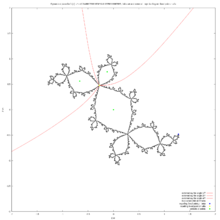分形/mcmullen
外观
< 分形
Curtis T McMullen 的 C 程序[1]
- 描述[2]
步骤
- 运行 tcsh
- make
- 将 ps2gif 脚本复制到每个子目录
- 将 ./ 添加到每个运行脚本
- 运行
- "大象的眼睛" 停留在主心形的内部角 p/q = 主 Misiurewicz 点
- julia.tar
-
在斐波那契点 c = -1.8705286321646448888906 处的曼德勃罗集
-
飞机 Julia 集。C 是实轴上周期 3 分量的中心
-
在周期 16 分量附近(尾流 1/16)的断开连接的 Julia 集
-
来自尾流 1/19 的断开连接的(康托尔)Julia 集
- kleinian.tar
-
球体上的克莱因群极限集
-
平面上肖特基(克莱因)群极限集
// from cx.c programs by Curtis T McMullen
// http://www.math.harvard.edu/~ctm/programs/home/prog/julia/src/julia.tar
/* Compute sqrt(z) in the half-plane perpendicular to w. */
complex contsqrt(z,w)
complex z,w;
{
complex cx_sqrt(), t;
t = cx_sqrt(z);
if (0 > (t.x*w.x + t.y*w.y))
{t.x = -t.x; t.y = -t.y;}
return(t);
}
/* Values in [-pi,pi]. */
double arg(z)
complex z;
{
return(atan2(z.y,z.x));
}
complex cx_exp(z)
complex z;
{
complex w;
double m;
m = exp(z.x);
w.x = m * cos(z.y);
w.y = m * sin(z.y);
return(w);
}
complex cx_log(z)
complex z;
{
complex w;
w.x = log(cx_abs(z));
w.y = arg(z);
return(w);
}
complex cx_sin(z)
complex z;
{
complex w;
w.x = sin(z.x) * cosh(z.y);
w.y = cos(z.x) * sinh(z.y);
return(w);
}
complex cx_cos(z)
complex z;
{
complex w;
w.x = cos(z.x) * cosh(z.y);
w.y = -sin(z.x) * sinh(z.y);
return(w);
}
complex cx_sinh(z)
complex z;
{
complex w;
w.x = sinh(z.x) * cos(z.y);
w.y = cosh(z.x) * sin(z.y);
return(w);
}
complex cx_cosh(z)
complex z;
{
complex w;
w.x = cosh(z.x) * cos(z.y);
w.y = sinh(z.x) * sin(z.y);
return(w);
}
complex power(z,t) /* Raise z to a real power t */
complex z;
double t;
{ double arg(), cx_abs(), pow();
complex polar();
return(polar(pow(cx_abs(z),t), t*arg(z)));
}
/* Map points in the unit disk onto the lower hemisphere of the
Riemann sphere by inverse stereographic projection.
Projecting, r -> s = 2r/(r^2 + 1); inverting this,
s -> r = (1 - sqrt(1-s^2))/s. */
complex disk_to_sphere(z)
complex z;
{ complex w;
double cx_abs(), r, s, sqrt();
s = cx_abs(z);
if (s == 0) return(z);
else r = (1 - sqrt(1-s*s))/s;
w.x = (r/s)*z.x;
w.y = (r/s)*z.y;
return(w);
}
complex mobius(a,b,c,d,z)
complex a,b,c,d,z;
{ return(divide(add(mult(a,z),b),
add(mult(c,z),d)));
}
// from quad.c programs by Curtis T McMullen
// http://www.math.harvard.edu/~ctm/programs/home/prog/julia/src/julia.tar
/* F : \cx-K(f) -> {Re z > 0} is the multivalued
function given by lim 2^{-n} log f^n(z).
Re F(z) = rate,
(Re F(z))/|F'(z)| = dist.
Returns 1 if z escaped, 0 otherwise.
*/
escape(z,c,iterlim,rate,dist)
complex z,c;
int iterlim;
double *rate, *dist;
{
int i;
double fp, r, s;
s = 1.0;
fp = 1.0;
for(i=0; i<iterlim; i++)
{ r = cx_abs(z);
if(r > LARGE)
{ *rate = log(r)/s;
*dist = r*log (r)/fp;
return(1);
}
fp = fp * 2.0 * r;
z = add(mult(z,z),c);
s = s * 2.0;
}
return(0);
}
// from quad.c programs by Curtis T McMullen
// http://www.math.harvard.edu/~ctm/programs/home/prog/julia/src/julia.tar
/* CAUTION is 2^{1/n} */
#define LOG2 .69314718055994530941
#define SQRT2 1.414213562373095
#define LARGE 200.0
#define LENGTH 200
#define CAUTION 0.9330329915368074
#define CIRCLEPTS 1000
#define EPS 0.000001
#define RAYEPS 1e-20
#define JFAC 1.0
/* Defaults */
#define C {0, 1}
#define CENTER {0.0,0.0}
#define RADIUS 1.5
#define PCLIM 0
#define SUBDIVIDE 8
#define ITERLIM 50
/* Analytically continue Riemann mapping */
/* F : unit disk -> \cx-K(f) */
/* Assuming F(r,ang) is approx. z, find exact value*/
complex riemann(r,ang,z)
double r;
rational ang;
complex z;
{
complex orb[LENGTH], neworb[LENGTH];
int i, n;
orb[0] = z;
n = 0;
for (i=0; i<LENGTH-1; i++)
{ if(cx_abs(orb[i]) > LARGE) break;
orb[i+1] =
add(mult(orb[i],orb[i]),c);
n++;
r = 2*r;
ang.num = (2*ang.num)%ang.den;
}
neworb[n] = polar(pow(2.0,r),2*PIVAL*ang.num/ang.den);
for(i=n; i>0; i--)
{ neworb[i-1] =
contsqrt(sub(neworb[i],c),orb[i-1]);
}
return(neworb[0]);
}
/* Set the color on a line joining z to w */
scan_line(z,w,col)
complex z, w;
int col;
{
int i, n;
complex u;
n = 4*cx_abs(sub(z,w))/pixrad;
if(n == 0)
{ scan_set(z,col);
return;
}
for(i=0; i<=n; i++)
{ u.x = (i*z.x + (n-i)*w.x)/n;
u.y = (i*z.y + (n-i)*w.y)/n;
scan_set(u,col);
}
}
/* Draw an external ray */
draw_ray(level,ang)
double level;
rational ang;
{
complex lastz, z;
double r;
r = level;
while(pow(2.0,r) < LARGE) r *= 2;
z = polar(pow(2.0,r),2*PIVAL*ang.num/ang.den);
do
{ r = r*CAUTION;
lastz = z;
z = riemann(r,ang,lastz);
if(r < level*0.99)
scan_line(lastz,z,RAY);
} while(r > RAYEPS);
}

该方法基于 Curtis McMullen[3] 的 C 程序及其由 Matjaz Erat[4] 编写的 Pascal 版本
这里有两个平面[5]
- w 平面(或 f0 平面)
- z 平面(fc 平面的动态平面)
该方法包含 3 个主要步骤
- 计算圆的外部射线在 平面 上的某些 w 点,这些点对应于角度 和不同的半径(光栅化)
- 其中
- 使用逆 Boettcher 映射 将 w 点映射到 z 点
- 绘制 z 点(并使用线段连接它们(线段是直线上由两个不同的端点界定的部分[6]))
第一步和最后一步很简单,但第二步并非如此,需要更多解释。
对于 平面 中给定的外部射线,射线上的每个点都有
- 常数 (以转数表示的外部角度)
- 可变半径
所以 射线的点由半径 参数化,可以使用 复数的指数形式
可以使用线性尺度沿着射线前进
t:1/3; /* example value */ R_Max:4; R_Min:1.1; for R:R_Max step -0.5 thru R_Min do w:R*exp(2*%pi*%i*t); /* Maxima allows non-integer values in for statement */
它会给出一些 w 点,它们之间具有相等的距离。
另一种方法是使用非线性尺度。
为了做到这一点,我们引入浮点指数 ,使得
和
为了在 平面上计算角度为 的外部射线的 w 点,使用以下 Maxima 代码
t:1/3; /* external angle in turns */ /* range for computing R ; as r tends to 0 R tends to 1 */ rMax:2; /* so Rmax=2^2=4 / rMin:0.1; /* rMin > 0 */ caution:0.93; /* positive number < 1 ; r:r*caution gives smaller r */ r:rMax; unless r<rMin do ( r:r*caution, /* new smaller r */ R:2^r, /* new smaller R */ w:R*exp(2*%pi*%i*t) /* new point w in f0 plane */ );
在这种方法中,点之间的距离并不相等,而是与填充的朱利亚集边界到点的距离成反比。
这很好,因为这里射线具有更大的 曲率,因此曲线将更加平滑。
- 在 平面上进行前向迭代
直到 接近无穷大
- 切换平面(从 到 )
(因为在这里,靠近无穷大: )
- 在 平面上进行反向迭代,迭代次数相同()
- 最后一个点 位于我们的外部射线上
步骤 1、2 和 4 很容易。第三步不容易。
反向迭代使用复数的平方根。它是一个双值函数,因此反向迭代会产生二叉树。
在没有额外信息的情况下,无法在这样的树中选择好的路径。为了解决这个问题,我们将使用以下两点
- 无穷大的吸引盆的等度连续性
- 和 平面之间的共轭关系
无穷大的吸引盆的等度连续性
[edit | edit source]无穷大的吸引盆(填充的 Julia 集的补集)包含在正向迭代下趋于无穷大的所有点。
无穷大是一个超吸引不动点,所有点的轨道都具有相似的行为。换句话说,如果两个点的初始位置很近,则假设它们的轨道会保持靠近。
这就是等度连续性(与正规性相比较)。
在 平面上,可以使用射线上先前点的正向轨道来计算下一个点的反向轨道。
算法的详细版本
[edit | edit source]- 计算射线上的第一个点(从无穷大附近开始,朝向 Julia 集移动)
- 其中
这里可以轻松地切换平面
这是我们射线的第一个 z 点。
- 计算射线的下一个 z 点
- 为 计算射线的下一个 w 点
- 计算 2 个点的向前迭代:之前的 z 点和实际的 w 点。保存 z 轨道和最后一个 w 点
- 切换平面并将最后一个 w 点用作起点:
- 使用之前 z 点的向前轨道,对新的 进行向后的迭代,以获得新的
- 是我们射线的下一个 z 点
- 依此类推(下一个点),直到
Maxima CAS 源代码
/* gives a list of z-points of external ray for angle t in turns and coefficient c */ GiveRay(t,c):= block( [r], /* range for drawing R=2^r ; as r tends to 0 R tends to 1 */ rMin:1E-20, /* 1E-4; rMin > 0 ; if rMin=0 then program has infinity loop !!!!! */ rMax:2, caution:0.9330329915368074, /* r:r*caution ; it gives smaller r */ /* upper limit for iteration */ R_max:300, /* */ zz:[], /* array for z points of ray in fc plane */ /* some w-points of external ray in f0 plane */ r:rMax, while 2^r<R_max do r:2*r, /* find point w on ray near infinity (R>=R_max) in f0 plane */ R:2^r, w:rectform(ev(R*exp(2*%pi*%i*t))), z:w, /* near infinity z=w */ zz:cons(z,zz), unless r<rMin do ( /* new smaller R */ r:r*caution, R:2^r, /* */ w:rectform(ev(R*exp(2*%pi*%i*t))), /* */ last_z:z, z:Psi_n(r,t,last_z,R_max), /* z=Psi_n(w) */ zz:cons(z,zz) ), return(zz) )$
逃逸时间的等高线
[edit | edit source]// from quad.c programs by Curtis T McMullen
// http://www.math.harvard.edu/~ctm/programs/home/prog/julia/src/julia.tar
/* Color a level curve of escape */
draw_level(level)
double level;
{
double r;
complex lastz, w, z;
static rational zero={0,1};
rational ang;
r = level;
while(pow(2.0,r) < LARGE) r *= 2;
z = polar(pow(2.0,r),0.0);
do
{ r = r * CAUTION;
lastz = z;
z = riemann(r,zero,lastz);
} while(r > level);
lastz = z;
ang.den = CIRCLEPTS;
for(ang.num=0; ang.num<=CIRCLEPTS; ang.num++)
{ z = riemann(level,ang,lastz);
if(ang.num>0) scan_line(z,lastz,LEVEL);
lastz = z;
}
}
颜色
[edit | edit source]// from quad.c programs by Curtis T McMullen
// http://www.math.harvard.edu/~ctm/programs/home/prog/julia/src/julia.tar
/* Colors */
#define FILLED_JULIA 0
#define JULIA 1
#define PC_SET 2
#define RAY 3
#define LEVEL 4
#define RESERVED 5
#define FREE (256-RESERVED)
set_gray(g)
double g;
{
int i;
scan_gray(FILLED_JULIA,g);
scan_gray(JULIA,0.0);
scan_gray(PC_SET,0.0);
scan_gray(RAY,0.0);
scan_gray(LEVEL,0.0);
for(i=0; i<FREE; i++)
scan_gray(RESERVED+i,1.0);
}
set_colors()
{
int i;
scan_hls(FILLED_JULIA,0.0,70.0,0.0);
scan_rgb(JULIA,0,0,0);
scan_rgb(PC_SET,0,255,0);
scan_rgb(RAY,0,0,0);
scan_rgb(LEVEL,0,0,0);
for(i=0; i<FREE; i++)
scan_hls(RESERVED+i,
((FREE-i)*360.0/FREE),50.0,100.0);
}
color(z)
complex z;
{
complex grad;
double rate, dist;
int i;
if(escape(z,c,iterlim,&rate,&dist))
{ if(dist < jfac*SQRT2*pixrad)
return(JULIA);
i = subdivide * log(rate)/LOG2;
while (i<0) i += FREE;
return(RESERVED + i%FREE);
}
return(FILLED_JULIA);
}
// from scan.c programs by Curtis T McMullen
// http://www.math.harvard.edu/~ctm/programs/home/prog/julia/src/julia.tar
scan_hls(i,h,l,s)
int i;
double h, l, s;
{
int r, g, b;
hlsrgb(h,l,s,&r,&g,&b);
red[i] = r; green[i] = g; blue[i] = b;
cmap = COLOR;
}
/* Convert hue/lightness/saturation to rgb */
/* Domain is [0,360] x [0,100] x [0,100]. */
/* Range is [0,255] x [0,255] x [0,255]. */
hlsrgb(h, l, s, r, g, b)
double h, l, s;
int *r, *g, *b;
{
double M, m;
double floor(), bound(), gun();
h = h - floor(h/360) * 360;
l = bound(0.0, l/100, 1.0);
s = bound(0.0, s/100, 1.0);
M = l + s*(l > 0.5 ? 1.0 - l : l);
m = 2*l - M;
*r = 255*gun(m, M, h);
*g = 255*gun(m, M, h-120);
*b = 255*gun(m, M, h-240);
}
double gun(m, M, h)
double m, M, h;
{
if(h < 0)
h += 360;
if(h < 60)
return(m + h*(M-m)/60);
if(h < 180)
return(M);
if(h < 240)
return(m + (240-h)*(M-m)/60);
return(m);
}
double bound(low, x, high)
double low, x, high;
{
if(x < low)
return(low);
if(x > high)
return(high);
return(x);
}




































